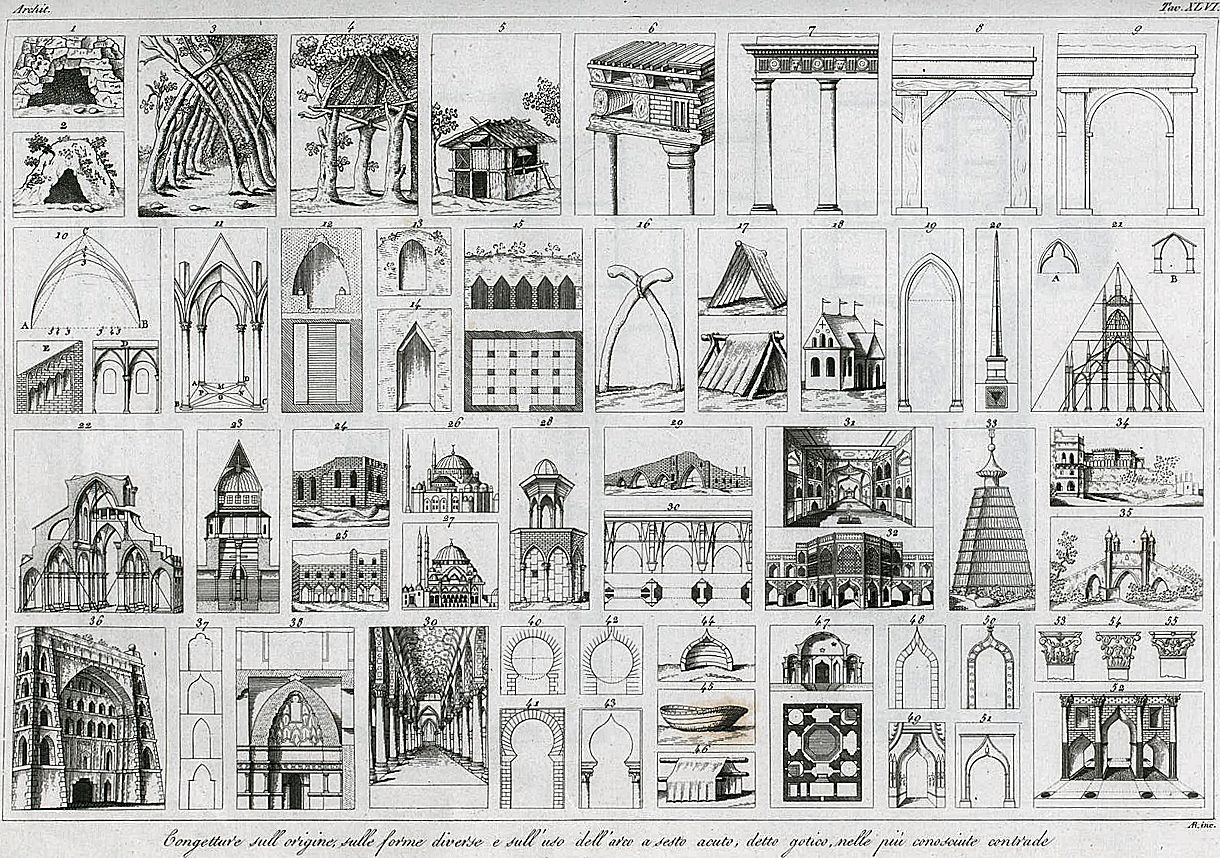1. Cavern cut out of rock for habitation.
2. Subterranean excavation, taking naturally the pointed form.
3. Alley of trees, also presenting the form of the pointed arch, which may have arisen by chance, or directed by the wants of man in forming the first habitations.
4. Other arrangements of trees for a similar purpose.
5. These same trees united with a certain regularity form a cottage with a roof covered with leaves and branches, and the wall filled in with straw and earth.
6. The first ornaments which the wooden house received.
7. Architecture perfected, preserves in the porticos and other constructions in stone, the form and ornaments of the first houses of wood.
8. Two supports, united diagonally to two wood pillars, to assist in supporting the architrave, may have readily given the idea of the pointed arch, or even the semicircular arch, indicated by the dotted line.
9. The semicircular arch executed in stone, suggested by the above.
10. Diagram of the different pointed arches, struck from centers of the divisions of the line 3rd, 4th, and 5th, and the equilateral arch struck from the extremities of the equilateral triangle. The figure E shows how the pointed arch may have grown out of the interlacing of a series of round arches, and the figure D how the same may have been suggested by the intersection of the round arches in different directions.
11. Pointed arches and vaulting resulting from the above.
12. Plan and section of an Etruscan tomb, discovered in 1764 at Castel-nuovo, in Tuscany, with the pointed arch.
13. The same pointed form is seen in the vault of an aqueduct excavated in the tufo by the Romans, in the environs of the antique Ardea, between Ostia and Capo d'Anzo.
14. Subterranean gallery in the catacombs of Rome, near the Gate Salara. It is covered by two strong tiles inclined one to the other, forming a kind of pointed vault.
15. A similar construction as observed in an antique cistern seen in a vineyard near Velletri.
16. Ribs of the whale, with which the fishermen of the north construct their cottages on the borders of the sea.
17. Tents of the wandering people inhabiting the southern countries.
18. House in Sweden, the roof of which forms the eqilateral triangle.
19. Gothic arch, fromed on the eqilateral triangle.
20. Obelisk, triangular on plan, found by Pococke near Nicoea in Asia Minor.
21. Cathedral of Milan; the whole of the proportions, exterior and interior, of this cathedral, are said to have been regulated on the eqilateral triangle.
22. Sectional view of the Cathedral of Bologna, constructed on the same principle, according to the original design for this church, but when it was completed in the fifteenth century the height of the nave was diminished as shown.
23. Transverse section of the Nilometer, at the south point of the island of Roudhah, between Old Cairo and Giza, built by the Saracens in 861; the vault of this edifice, as also the opening to the upper part, by which the waters of the river enter, are pointed.
24. Remains of an aqueduct constructed at Cairo by the Arabian caliphs; the arches are pointed.
25. Remains of an Arabian palace at Cairo.
26. Mosque of Mahomet II at Constantinople.
27. Another mosque at Constantinople, called the Solimania, built in the seventeenth century, with pointed arches.
28. Exterior of the Holy Sepulchre at Jerusalem; the arches are pointed. The general plan is given pl. 73/44.
29. Bridge in Georgia.
30. Portion of an aqueduct at Bourgasm near Constantinople; see pl. 27/17, 18, 19.
31. Saloon called the "Paradise," seen by Chardin in a garden at Ispahan.
32. Palace in the same town.
33. Pagoda at Deogur in India.
34. Remains of a palace at Gasipour, on the borders of the Ganges.
35. Bridge over the River Odoanulla, near Rajemahel, sixteenth century.
36. Triumphal arch and mausoleum of an Indian vizir; built in the fourteenth century.
37. Different kinds of arches employed in the above.
38. The saloon on the ground floor of the Arabian palace, the Zisa, near Palarmo; see pl. 44/12-16.
39. Interior of the royal palace, Palermo, founded in 1132 by Roger, the first king of Sicily.
40. The horseshoe arch.
41. The gate of Victory, Cairo.
42. Modification of the horseshoe arch at the summit.
43. The same form of arch from the Alhambra.
44. The section of an Arabian boat reversed, showing an analogous form.
45. The Arabian boat in its natural position.
46. Form of the tents in use amongst the Moors.
47. Plan and section of an Arabian bath at Bude in Hungary.
48. Door of an ancient monastery in Sweden.
49. Gate of a similar form, from an ancient building in England.
50. Door of the ancient Hotel Barbetti, Paris, as it appeared in 1748.
51. Door of the cloister of the Monastery of St. Scholastica at Subiaco; vide pl. 35, fig. P.
52. Plan and view of a triumphal arch at Antinoč, Antinopolis, in Egypt.
53. Antique capital from the Villa Adriani, near Tivoli, which has some analogy with the capitals of the columns of the triumphal arch of Antinopolis.
54. Capital of one of the columns of the triumphal arch.
55. Similar capital from the pilasters of the gate of Adrian in Athens.
| |

|